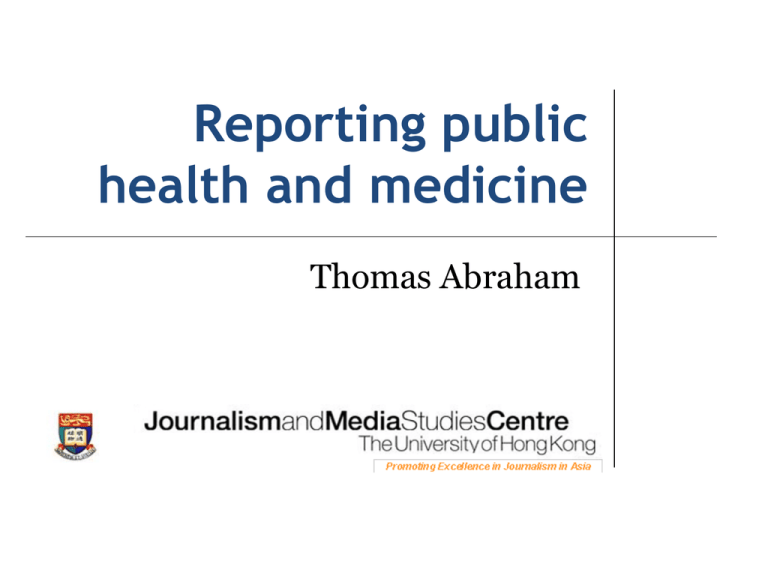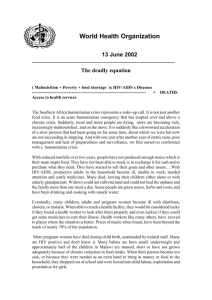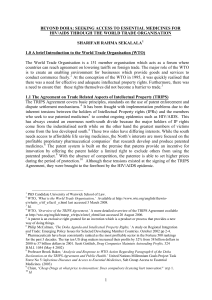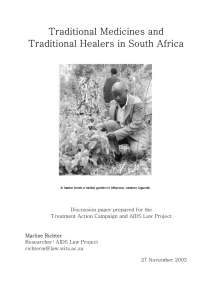Introduction - JMSC Courses
advertisement

Reporting public health and medicine Thomas Abraham Today’s class Introduction to health and medical news Course objectives and course outline Organizing our course work "The observed number of two GBS cases among vaccinated persons so far lies within normal expectation of baseline incidence that would occur in a population of 170,000 (regardless of vaccination history), adjusted for age and seasonal effects," the spokesman said. This is about life and death Experts are often divided There are often commercial, political and personal interests at play The public depend on you for information on which they can act This is about life and death Experts are often divided There are often commercial, political and personal interests at play The public depend on you for information on which they can act Life and death at a global level: global health issues “AIDS is not just another public health threat, but now belongs in the league of make-or break issues of our times-together with mass poverty, climate change and terrorism.” Peter Piot, former head of UNAIDS Today, 12,000 people are likely to be infected with HIV/AIDS and 6,000 are likely to die http://www.globalhealthfacts.org/topic.jsp?i=1#table Other diseases 2,500 children, mostly under the age of five, are likely to die today in sub Saharan Africa of malaria. Diarrhoeal disease kills 1.5 million children every year. Tuberculosis kills 1.8 million people a year By reporting on these issues, intelligently journalism can persuade governments to take action Why study health and medical reporting? If you are good at it, you can make a difference! Three areas of health and medical reporting Medicine Public health Health policy 1. Health policy How should health care be provided? By the government, or by private businesses and foundations? Should the cost of health care be borne by individuals, or by society as a whole? Should all members of a society have a right to health care regardless of their ability to pay? How much should a society spend on health care? 2. Medical reporting Largely about new treatments for diseases Three main sources -articles in scientific journals -scientific conferences -press conferences by scientists -Reports by WHO and other scientific organizations The challenges of medical reporting 1. Understanding and interpreting medical trials, and the principles of evidence based medicine http://www.cbsnews.com/video/watch/?id =7123744n&tag=cbsnewsSectionsArea.3 Understanding the power of money 2. Understanding the power of money: the global pharmaceutical industry is a US $500 billion dollar a year industry, facing severe competitive, regulatory and economic pressures http://www.youtube.com/watch?v=lNFuEcy5e kg Understanding the power of money “Some of the expensive drugs available today have only modest therapeutic benefits, while many inexpensive medicines are highly effective and safe.” “Manufacturers provide a stream of new products for the medicines market place, usually at higher prices than existing products.” WHO Report “The World’s Medicines Situation Understanding the power of money Medical research is fuelled by money: -from industry -from foundations -from governments and public money Even scientific journals are commercial enterprises 3. Public health Public health is concerned with the health of communities and societies Clinical medicine on the other hand focuses on disease in individual patients Public health studies ways to improve community health through disease prevention Public health interventions to improve community health include improving sanitation, promoting healthier lifestyles, vaccinations etc. Some definitions of public health “The science and art of preventing disease, prolonging life and promoting health through the organised efforts of society” Sir Donald Acheson “What we as a society do collectively to assure the conditions in which people can be healthy” Institute of Medicine. USA Which of these headlines is about public health, and which is not? “Government unveils new measures to reduce road side pollution” “New surgical treatment increases success rate of liver transplants” “Vietnam announces fresh outbreak of bird flu” “Outbreak of diarrhoea forces kindergarten closure” “New drug dramatically reduces high blood pressure” A game to try out… Outbreak at Watersedge: Public Health Simulation Game (http://www.mclph.umn.edu/watersedge/) The demand for health and medical journalism http://www.reuters.com/news/health http://www.bbc.co.uk/news/health/ http://www.nytimes.com/pages/health/index.html http://www.cbsnews.com/2718-500202_162-489.html?tag=related www.bmj.com www.thelancet.com http://www.kaiserhealthnews.org/ http://www.cidrap.umn.edu/ Course objectives To understand the principles of good public health and medical reporting To understand the sources of scientific and health information and how to use them To learn to understand and interpret scientific and health information and turn them into clear, intelligent news reports. To give you the skills to work the health beat in a news organization Home work Sign up for news alerts, the Lancet (www.thelancet.com), the New England Journal of Medicine, Science and Nature Follow the Eurekalert web site http://www.eurekalert.org Read first two chapters of The Rise and Fall of Modern Medicine Course work You will chose a topic in medicine or public health you are interested in ( ie cancer, HIV/AIDS, influenza, mental illnesses etc) and write 3 stories of around 400-500 words each based on new findings in journals(50% of grade) You will complete on line courses in HIV/AIDS, tuberculosis and malaria at http://www.globalhealthlearning.org/login.cfm (20% of grade) Read a review a book on from the list in your syllabus (20%) Class contributions ( 10%) Deadlines next class



![Thomas Cueni, Director-General, Interpharma [PPTX 1.78MB]](http://s2.studylib.net/store/data/015100071_1-7daf132622127d72bbf5cb92425a5e96-300x300.png)







